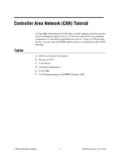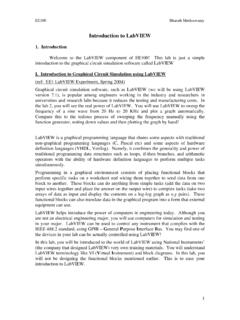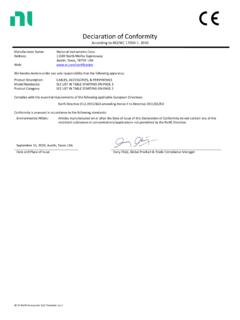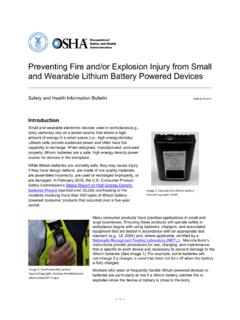Transcription of Introduction to Bluetooth Device Testing - NI
1 September 2016 Introduction to Bluetooth Device Testing From Theory To Transmitter and Receiver Measurements 2 Visit Introduction to Bluetooth Device Testing From Theory to Transmitter and Receiver Measurements Table of Contents Table of Contents .. 2 1. Overview .. 4 Introduction .. 4 History of Bluetooth .. 6 Bluetooth physical Layer (PHY) Radio Characteristics .. 8 Frequency bands and channel arrangement .. 10 Frequency Hopping .. 11 Modulation .. 11 Transmit 16 Receiver Sensitivity .. 16 Bluetooth Baseband Characteristics.
2 18 Network Topology .. 20 Packet types .. 22 Bluetooth Device Addressing (BD_ADDR) .. 25 Timing Scheme and Hopping 26 Bluetooth Test Modes .. 28 2. NI s approach to Bluetooth Testing .. 33 3. Transmitter 34 Power Tests .. 38 Output Power .. 38 Power density .. 42 Power control .. 43 Enhanced data rate relative transmit power .. 44 Modulation tests .. 46 Modulation Characteristics .. 46 Initial Carrier Frequency Tolerance (ICFT) .. 49 Carrier Frequency Drift .. 52 Enhanced data rate carrier frequency stability and modulation accuracy .. 57 Enhanced data rate differential phase encoding.
3 60 Spectrum Measurements .. 62 Tx output spectrum-frequency range .. 62 3 Visit Introduction to Bluetooth Device Testing From Theory to Transmitter and Receiver Measurements Tx output spectrum-20 dB bandwidth .. 64 Tx output spectrum-adjacent channel power .. 65 In-band spurious emission .. 68 4. Receiver Measurements .. 73 Sensitivity .. 77 EDR BER Floor Performance .. 83 Maximum Input Signal Level .. 84 Intermodulation .. 85 Carrier-to-Interference, 88 Blocking Performance .. 94 5. Appendix A: Bluetooth Test Spec (Additional Information).
4 97 6. Appendix B. NI solutions for Bluetooth Test .. 102 Modular PXI Platform for Bluetooth Test using NI RF Instruments and the Bluetooth Measurement Suite .. 102 Production Test of Bluetooth Devices with the Wireless Test System (WTS) .. 116 7. Appendix C. Symbols and Acronyms .. 118 8. References .. 119 4 Visit Introduction to Bluetooth Device Testing From Theory to Transmitter and Receiver Measurements 1. Overview Introduction Bluetooth is a global wireless standard that enables connectivity for a wide range of electronic devices ranging from mobile phones to medical devices, computers, and even toothbrushes.
5 Bluetooth technology eliminates the need for a cable connection between devices by connecting them over short distances (up to 100m) using short-wavelength radio transmissions in the unlicensed industrial, scientific, and medical (ISM) band from to GHz. Figure 1 Bluetooth Operating Spectrum While other protocols like Zigbee and RFID can be used to connect networks of sensors and build connectivity across devices, Bluetooth is pre-existing in common consumer electronics. The accessibility of Bluetooth makes it a perfect standard for connecting devices within personal area network (PAN) space.
6 Up to seven devices can be connected over Bluetooth to form a piconet. WLAN, commonly known as Wi-Fi, can also be used for some of the Bluetooth applications like streaming audio, however, Bluetooth s ability to utilize the entire spectrum of GHz to GHz makes it ideal for robust, short-range wireless transmission in congested radio environments where WLAN devices can run into performance issues. To ensure robust operation in the interference-dominated ISM band, Bluetooth uses spread spectrum, frequency hopping, full-duplex signal at a nominal rate of 1600 hops per second for basic and enhanced data rate transmissions.
7 5 Visit Introduction to Bluetooth Device Testing From Theory to Transmitter and Receiver Measurements Bluetooth allows for high-quality data and audio streaming between devices, as well as the creation of sensors smaller than ever before. Bluetooth Smart, or Bluetooth Low-Energy, has allowed for coin-cell battery, solar, and kinetic powered sensors to be placed almost anywhere. The combination of Bluetooth BR/EDR and Bluetooth LE lets devices communicate to applications in an ultra-power efficient way which makes it a prime technology for the Internet of Things, IoT.
8 A typical Bluetooth module consists of four main components: radio transceiver, baseband/link controller, link manager and a host controller interface (HCI). HCI connects a Bluetooth system with the host system and provides a uniform interface method of accessing the Bluetooth hardware capabilities by the host system. Figure 2 Bluetooth System Stack This document provides a brief summary of major baseband and radio ( physical layer) characteristics of the Bluetooth standard and then discusses some of the typical measurements required for Device certification according to Bluetooth standard.
9 The following versions of the standard will be covered , , , , , and 6 Visit Introduction to Bluetooth Device Testing From Theory to Transmitter and Receiver Measurements History of Bluetooth Bluetooth technology was invented in 1994 by a group of engineers at Ericsson. The name Bluetooth originates from the name of the 10th century Danish King Harald Bl tand or Harold Bluetooth in English. During his reign, King Bluetooth united dissonant tribes in Sweden, Norway, and Denmark into a single kingdom. Similarly, Bluetooth technology provides a method of uniting electronic devices through a wireless communications link.
10 There are several versions of the Bluetooth standard. The first version of Bluetooth standard was which was released in 1999 by Bluetooth Special Interest Group (SIG). Bluetooth SIG oversees the development of the Bluetooth standard as well as licensing of the Bluetooth technology to the manufacturers. Manufacturers of Bluetooth -compliant devices can pursue the Bluetooth certification with Bluetooth SIG, which allows them to use the Bluetooth logo, shown in Figure 3, on Bluetooth -compliant devices. Figure 3. Bluetooth logo 7 Visit Introduction to Bluetooth Device Testing From Theory to Transmitter and Receiver Measurements Year Bluetooth Standard Data Rate Modulation Notes 1999 1 Mb/s GFSK The Bluetooth Specification is released by the Bluetooth SIG 2003 1 Mb/s GFSK First FDA-approved Bluetooth medical system.













